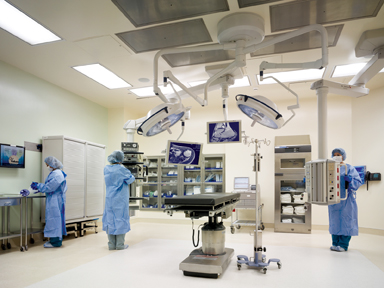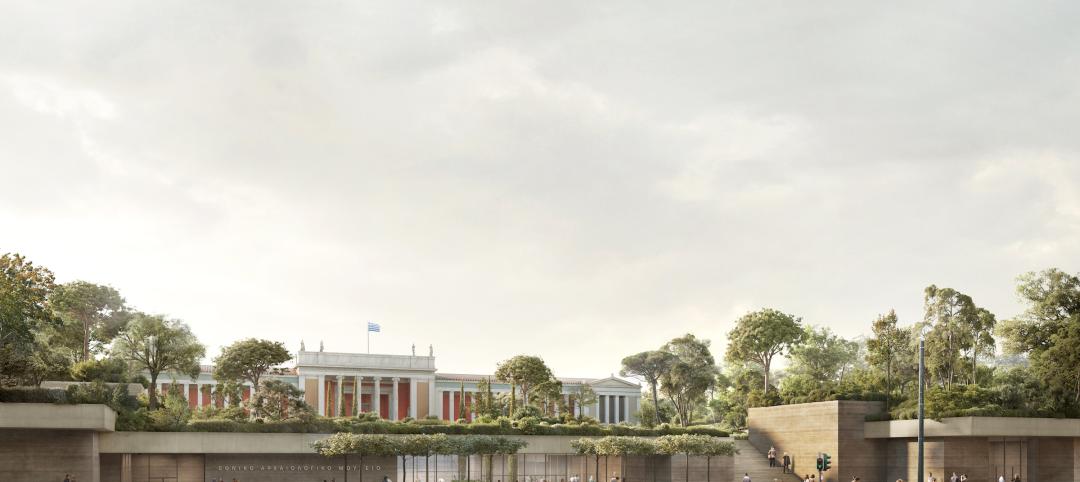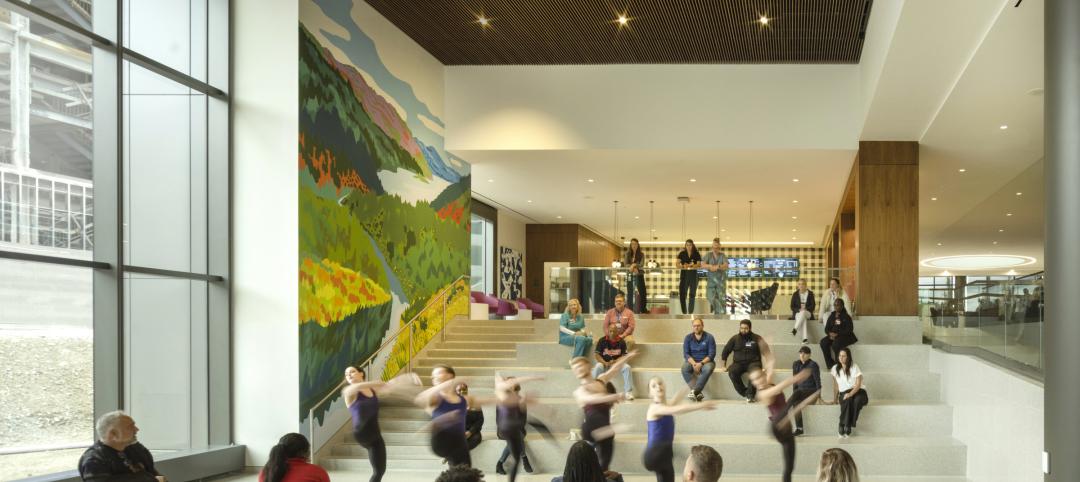The healthcare sector faces grave financial uncertainties, even with the June 28 Supreme Court decision upholding the Affordable Care Act. To help us sort out the factors impacting this lucrative segment, we turned to Philip Tobey, a Fellow of both the AIA and the American College of Healthcare Architects and Senior Vice President with SmithGroupJJR.
“Health industry providers legitimately expect significant efficiencies and lower costs for design and construction services, to go along with the economies that they themselves face with tighter and value-based reimbursement terms under health reform,” says Tobey, a member of Building Design+Construction’s Editorial Board.
In other words, AEC firms are going to have to share some of their healthcare clients’ pain. The drive for greater operational efficiency and lower cost in healthcare will be unrelenting, with bundled payments and shared savings models in lieu of traditional fee-for-service reimbursement forcing healthcare providers to eliminate wasteful practices.
Tobey sees three major trends emerging: 1) growing emphasis on ambulatory care, 2) medical systems integration, and 3) the “bundling/unbundling” of services.
SCROLL DOWN FOR GIANTS 300 TOP 25 AEC HEALTHCARE FIRM RANKINGS
1. PUSHING AMBULATORY CARE FACILITIES OUT
“The trend to push services out of the hospital into ambulatory settings will only intensify,” says Tobey. He notes, however, that there will be an “overwhelming need” to expand the front end of delivery—primary care, urgent care, and emergency departments—and to rationalize procedural and imaging resource capacity. At the same time, freestanding surgery and imaging centers may not be as prevalent in the future, and may need to be consolidated into larger hospital centers.
“Hospitals are not going away,” says Tobey, even though inpatient volumes are predicted to fall 5%, vs. 30% growth in outpatient volume. The sheer increased volume of patients, especially as baby boomers age, will inevitably drive up acute-care admissions. In the face of these seemingly countervailing trends, says Tobey, “The need to renovate outdated or obsolete facilities will be a strong driver in the healthcare business.”
2. INTEGRATING MEDICAL SYSTEMS MORE TIGHTLY
Tobey says the need for greater efficiency and ever-higher quality of care are not new goals for medical care or medical design, but hospital systems are being encouraged further by healthcare reform to streamline processes, with more mergers, acquisitions, and hospital-physician staff integrations on the horizon. “The industry’s even been talking about including services like long-term care and home care into this integrated approach,” he says.
Although there will always be a need for acute-care hospitals, Tobey sees a possible shift toward more community-based portals. As health systems continue to integrate, they will rely more and more on treatment venues outside the hospital to provide patients with coordinated preventive care and treatment for chronic conditions.
The IT component of hospital systems is already a natural for systems integration. “Providing the right information where it’s needed is essential for clinical care,” says Tobey, who foresees greater implementation of electronic medical records.
Are hospitals ready for lean?
“Everybody’s talking about it, but many hospital owners are wary of taking on lean,” says SmithGroupJJR’s Phil Tobey, FAIA, FACHA, whose firm is on the team for Sutter Health’s California Pacific Medical Center in San Francisco, the largest lean project in the U.S. “You have Sutter, which is totally lean, then you have clients who tell us not even to mention the word,” he says. “Others are applying the basic principles of lean construction without carrying the heavy weight of all that lean entails.”
Applying Lean/Six Sigma principles to healthcare, says Jeffrey C. Stouffer, AIA, a Principal with HKS, would result in “measurable outcomes and even risk sharing as part of the design and construction process” by eliminating unnecessary waste in construction and operations and increasing staff efficiency and safety, while reducing energy and staff costs for the hospital.
3. UNBUNDLING/BUNDLING OF HEALTHCARE SERVICES
Healthcare providers are “decanting” non-core functions—services like pharmacy, lab support, materials handling, and environmental management—from the mother ship into cheaper B-occupancy buildings. “Anything soft, anything that’s not high-tech, is being taken out,” says Tobey. “That’s the unbundling.”
However, once the unbundling of less-intense services has been accomplished, says Tobey, some hospital systems are opting to bundle the remaining hospital space, by placing beds back on top of the structure’s base diagnostic and support block, instead of having the traditional diagnostic/support chassis with attached nursing wings.
“You unbundle and decant the support services, then take the remaining high-intensity hospital base and put the beds on top,” says Tobey. A recent study for a 100-bed community hospital found that following such a scheme would result in 39% savings in construction costs per bed. +
TOP 25 HEALTHCARE SECTOR ARCHITECTURE FIRMS
| Rank | Company | 2011 Healthcare Revenue ($) |
| 1 | HDR Architecture | 205,200,000 |
| 2 | HKS | 124,736,964 |
| 3 | Perkins+Will | 122,895,589 |
| 4 | Cannon Design | 121,000,000 |
| 5 | NBBJ | 116,401,000 |
| 6 | HOK | 102,695,248 |
| 7 | SmithGroupJJR | 74,600,000 |
| 8 | RTKL Associates | 68,421,405 |
| 9 | Perkins Eastman | 63,700,000 |
| 10 | Hammel, Green and Abrahamson | 61,900,000 |
| 11 | ZGF Architects | 54,338,355 |
| 12 | Heery International | 48,583,000 |
| 13 | HMC Architects | 42,715,899 |
| 14 | PageSoutherlandPage | 38,670,000 |
| 15 | IBI Group | 37,349,554 |
| 16 | Skidmore, Owings & Merrill | 33,950,000 |
| 17 | FKP Architects | 33,947,200 |
| 18 | Gresham, Smith and Partners | 32,876,981 |
| 19 | FreemanWhite | 28,500,000 |
| 20 | RBB Architects | 28,500,000 |
| 21 | LEO A DALY | 26,900,325 |
| 22 | BSA LifeStructures | 26,323,759 |
| 23 | EwingCole | 24,000,000 |
| 24 | KMD Architects | 20,161,678 |
| 25 | Ennead Architects | 19,875,000 |
TOP 25 HEALTHCARE SECTOR ENGINEERING FIRMS
| Rank | Company | 2011 Healthcare Revenue ($) |
| 1 | AECOM Technology Corp. | 314,000,000 |
| 2 | Stantec | 109,980,000 |
| 3 | URS Corp. | 41,298,918 |
| 4 | Smith Seckman Reid | 38,300,000 |
| 5 | Jacobs | 32,950,000 |
| 6 | Parsons Brinckerhoff | 30,600,000 |
| 7 | KPFF Consulting Engineers | 28,000,000 |
| 8 | TTG|TMAD TAYLOR & GAINES | 27,677,900 |
| 9 | Mazzetti Nash Lipsey Burch | 24,988,296 |
| 10 | Degenkolb Engineers | 22,454,591 |
| 11 | Allen & Shariff | 21,577,769 |
| 12 | Bard, Rao + Athanas Consulting Engineers | 18,000,000 |
| 13 | ccrd partners | 17,100,000 |
| 14 | Atkins North America | 16,173,240 |
| 15 | AKF Group | 15,200,000 |
| 16 | KJWW Engineering Consultants | 14,607,369 |
| 17 | Syska Hennessy Group | 14,462,238 |
| 18 | Zak Companies | 13,882,705 |
| 19 | TLC Engineering for Architecture | 13,874,283 |
| 20 | Dewberry | 10,613,564 |
| 21 | Thornton Tomasetti | 9,860,000 |
| 22 | Sparling | 9,658,825 |
| 23 | Walter P Moore | 7,718,326 |
| 24 | M/E Engineering | 7,700,000 |
| 25 | Rutherford & Chekene | 7,650,000 |
TOP 25 HEALTHCARE SECTOR CONSTRUCTION FIRMS
| Rank | Company | 2011 Healthcare Revenue ($) |
| 1 | Turner Corporation, The | 1,807,050,000 |
| 2 | McCarthy Holdings | 1,231,000,000 |
| 3 | Gilbane Building Co. | 1,091,777,000 |
| 4 | Clark Group | 1,067,411,678 |
| 5 | PCL Construction Enterprises | 869,130,091 |
| 6 | Brasfield & Gorrie | 833,522,003 |
| 7 | Skanska USA | 724,418,042 |
| 8 | JE Dunn Construction | 636,206,095 |
| 9 | Robins & Morton | 599,073,000 |
| 10 | DPR Construction | 588,199,172 |
| 11 | Whiting-Turner Contracting Co., The | 464,779,240 |
| 12 | Mortenson | 455,620,000 |
| 13 | Lend Lease | 434,626,482 |
| 14 | Hensel Phelps Construction | 425,760,000 |
| 15 | Suffolk Construction | 420,343,563 |
| 16 | Pepper Construction Group | 415,064,000 |
| 17 | Tutor Perini Corp. | 409,583,000 |
| 18 | Balfour Beatty US | 389,253,907 |
| 19 | Hunt Construction Group | 369,500,000 |
| 20 | Hoar Construction | 313,937,000 |
| 21 | Flintco | 291,400,000 |
| 22 | Layton Construction | 287,300,000 |
| 23 | HBE Corp. | 279,200,000 |
| 24 | Power Construction | 275,000,000 |
| 25 | Swinerton | 274,627,440 |
Related Stories
Architects | Feb 27, 2023
Hord Coplan Macht announces retirement of Founder/CEO Lee Coplan, FAIA, and names successor
Hord Coplan Macht, an award-winning integrated architecture, interior design, landscape architecture, and planning firm, announces the retirement of Founder and Chief Executive Officer Lee Coplan, FAIA. Lee leaves behind a long and celebrated career leading the practice over the last four decades while bringing innovative design strategies and leadership to the architecture and design community.
Libraries | Feb 26, 2023
A $17 million public library in California replaces one that was damaged in a 2010 earthquake
California’s El Centro community, about two hours east of San Diego, recently opened a new $17 million public library. With design by Ferguson Pape Baldwin Architects and engineering services by Latitude 33 Planning & Engineering, the 19,811-sf building replaces the previous library, which was built in the early 1900s, damaged by a 7.2 earthquake that struck Baja California in 2010, and demolished in 2016.
Architects | Feb 24, 2023
7 takeaways from HKS’s yearlong study on brain health in the workplace
Managing distractions, avoiding multitasking, and cognitive training are key to staff wellbeing and productivity, according to a yearlong study of HKS employees in partnership with the University of Texas at Dallas’ Center for BrainHealth.
University Buildings | Feb 23, 2023
Johns Hopkins shares design for new medical campus building named in honor of Henrietta Lacks
In November, Johns Hopkins University and Johns Hopkins Medicine shared the initial design plans for a campus building project named in honor of Henrietta Lacks, the Baltimore County woman whose cells have advanced medicine around the world. Diagnosed with cervical cancer, Lacks, an African-American mother of five, sought treatment at the Johns Hopkins Hospital in the early 1950s. Named HeLa cells, the cell line that began with Lacks has contributed to numerous medical breakthroughs.
Arenas | Feb 23, 2023
Using data to design the sports venue of the future
Former video game developer Abe Stein and HOK's Bill Johnson discuss how to use data to design stadiums and arenas that keep fans engaged and eager to return.
Museums | Feb 22, 2023
David Chipperfield's 'subterranean' design wins competition for National Archaeological Museum in Athens
Berlin-based David Chipperfield Architects was selected as the winner of the design competition for the new National Archaeological Museum in Athens. The project will modernize and expand the original neoclassical museum designed by Ludwig Lange and Ernst Ziller (1866-1874) with new spaces that follow the existing topography of the site. It will add approximately 20,000 sm of space to the existing museum, as well as a rooftop park that will be open to the public.
Multifamily Housing | Feb 21, 2023
Watch: DBA Architects' Bryan Moore talks micro communities and the benefits of walkable neighborhoods
What is a micro-community? Where are they most prevalent? What’s the future for micro communities? These questions (and more) addressed by Bryan Moore, President and CEO of DBA Architects.
Healthcare Facilities | Feb 21, 2023
Cleveland's Glick Center hospital anchors neighborhood revitalization
The newly opened MetroHealth Glick Center in Cleveland, a replacement acute care hospital for MetroHealth, is the centerpiece of a neighborhood revitalization. The eleven-story structure is located within a ‘hospital-in-a-park’ setting that will provide a bucolic space to the community where public green space is lacking. It will connect patients, visitors, and staff to the emotional and physical benefits of nature.
Multifamily Housing | Feb 21, 2023
Multifamily housing investors favoring properties in the Sun Belt
Multifamily housing investors are gravitating toward Sun Belt markets with strong job and population growth, according to new research from Yardi Matrix. Despite a sharp second-half slowdown, last year’s nationwide $187 billion transaction volume was the second-highest annual total ever.
Multifamily Housing | Feb 21, 2023
New multifamily housing and mixed-use buildings in Portland, Ore., must be ready for electric vehicle charging
The Portland, Ore., City Council recently voted unanimously to require all new residential and mixed-use buildings to be ready for electric vehicle charging. The move amends Portland’s zoning laws to require all new multi-dwelling and mixed-use development of five or more units with onsite parking to provide electric vehicle charging infrastructure.

















